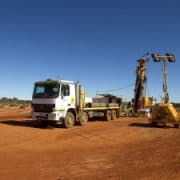Gold Road Resources Focus now firmly on WA expansion
THE CONFERENCE CALLER: Having helped establish a Tier 1 gold operation in its home state of Western Australia, Gold Road Resources (ASX: GOR) is seeking more ounces through increased production and the discovery of enough new ore bodies to establish another mine. By Mark Fraser
Following the first pour at the company’s 50 per cent-owned Gruyere project in June last year, Gold Road and its Joint Venture partner (and operator) Gold Fields (JSE and NYSE: GFI) produced 230,590 gold ounces during the mine’s first 12 months at an all-in sustainable cost of $1,155 per ounce.
The 2020 annual guidance is currently 250-270,000 ounces at an AISC of $1,250-1,350 per ounce.
Located in WA’s north east Goldfields on the under-explored Yamarna Greenstone Belt, Gruyere has a 12-year life based essentially on what was a six million ounces discovery by Gold Road back in 2013.
As it stands the deposit has a total mineral resource of 154 million tonnes grading 1.34 grams per tonne gold for 6.62 million ounces, as well as an ore reserve of 93 million tonnes at 1.24g/t gold for 3.72 million ounces.
Gold Road is now confident it can find more ore to feed the Gruyere mill, and has subsequently put aside $26 million to explore the 4,500 square kilometres it holds in the Yamarna belt.
The company is also looking at increasing plant throughput and deepening the current pit.
Speaking during the Diggers & Dealers Mining Forum in Kalgoorlie-Boulder, Gold Road managing director and chief executive Duncan Gibbs suggested a rise in output could involve expanding plant operating times, mining at a higher rate and reducing unit operating costs.
“We believe if we put those elements together, along with some steepening of the pit walls, we can drive the pit to a deeper level than the one which came out of the bankable feasibility study,” Gibbs said.
“Conceptually we think we can get the pit down to somewhere like 400-450 metres below surface – that becomes one of the deepest pits in Western Australia.
“Of course, to get that right we need to understand the geotechnical parameters as well; we’ve done some geotechnical and metallurgical drilling under the pit, so we have that information.
“We really want to get an understanding of the fresh rock exposure in the mine before we start to lock in the commitment and the understanding of what the life of mine reserve looks like for Gruyere.”
In terms of exploration, Gibbs said around 75 per cent of the $26 million put aside for the Yamarna belt would be channelled towards the 800sqkm southern project area, where the high priority targets were Kingston (with its diamond hole of 1m at 10.4 g/t), Hirono, Savoie and Beefwood as well as Gilmour and Gilmour South.
The other project area is at Yandina in WA’s south west Yilgarn, which sits within an under-explored greenstone belt near the farming community of Lake Grace.
Here, Gold Road and Cygnus Gold control 3,400sqkm of land covering two joint venture areas, with the former planning to take over the role of operator.
Some 20,000m of aircore drilling targeting crustal scale shear zones have already been completed, while a field program consisting of another 8,500m of aircore, 750m of RC and 500m of diamond drilling is now underway.
“What we see is the opportunity here for a large scale, regional geochem corridor stretch over about 15 km, and the opportunity really is to follow up the aircore results that we have,” Gibbs said.
“And hopefully we can make a discovery in this part of the Australia.”
Gold Road became debt free in July, while it also has $65 million of franking credits as a consequence of its 50 per cent sale of Gruyere to Gold Fields.
Given this, Gibbs added, the resources house was now, “in a position to pay fully franked dividends.”
Email: perth@goldroad.com.au
Web: www.goldroad.com.au





